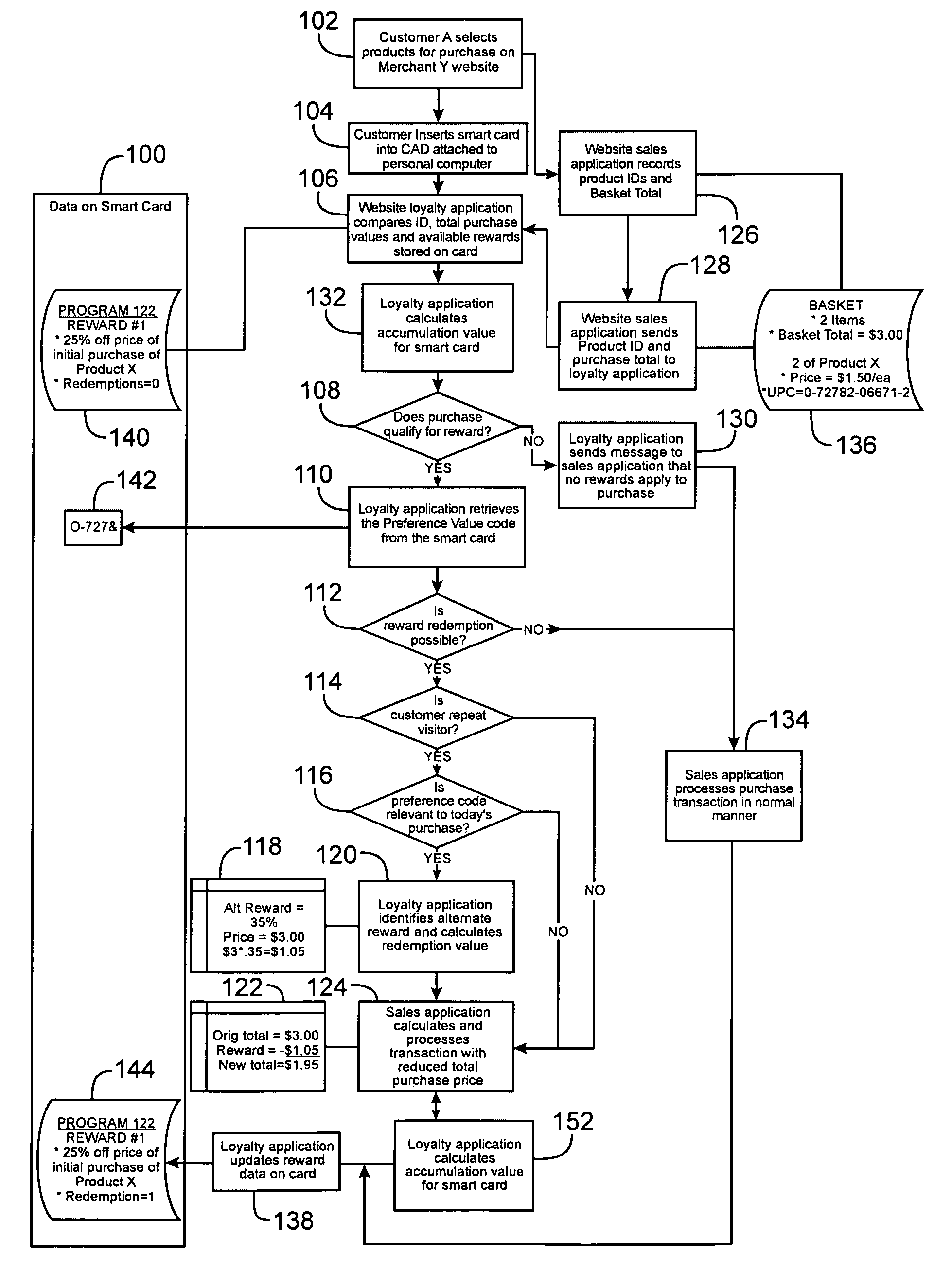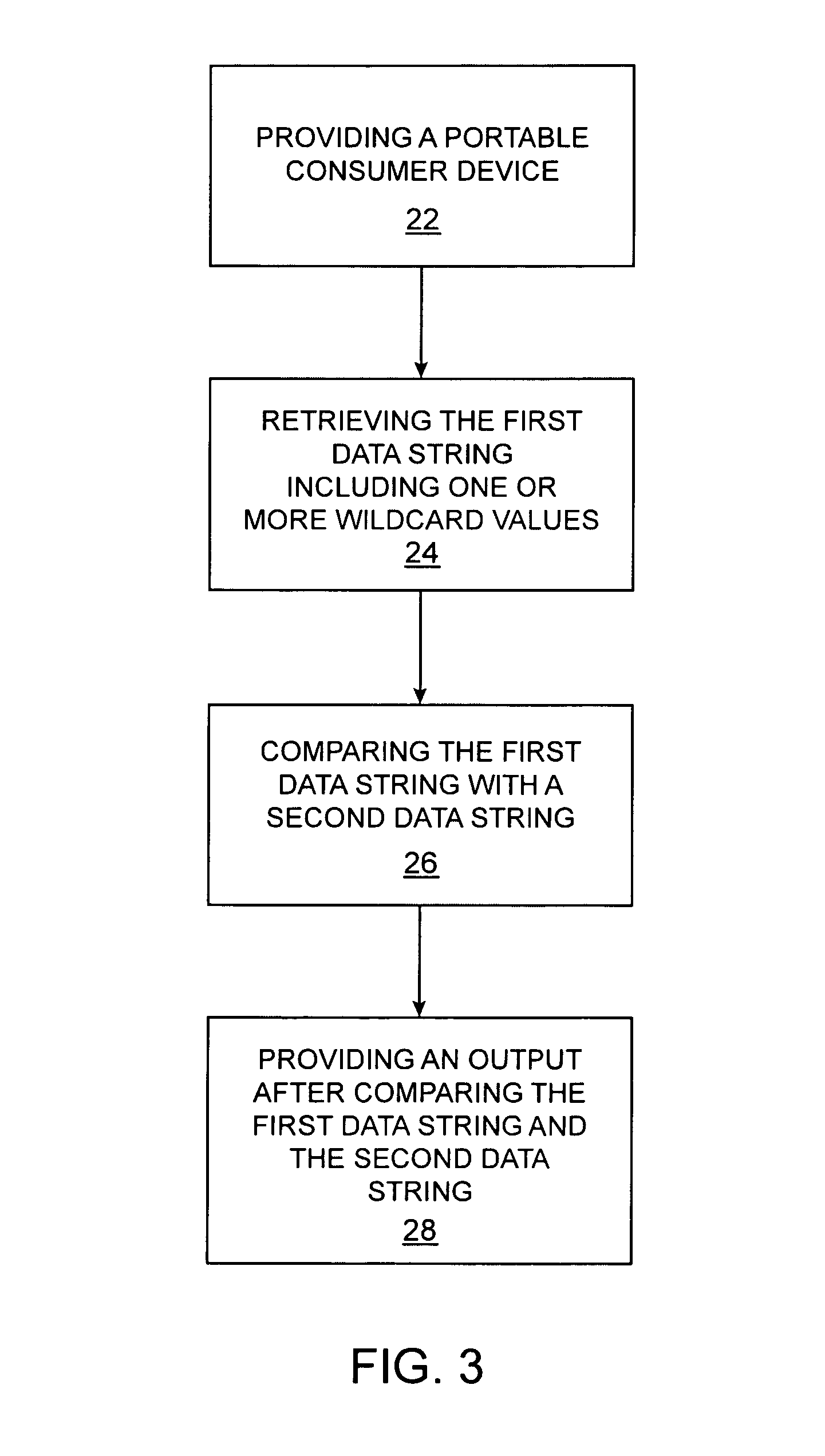Method, system and portable consumer device using wildcard values
a consumer device and wildcard technology, applied in the field of methods, system and portable consumer devices using wildcard values, can solve the problems of limited data storage capacity in the memory of the smart card and inability to do practical things
- Summary
- Abstract
- Description
- Claims
- Application Information
AI Technical Summary
Benefits of technology
Problems solved by technology
Method used
Image
Examples
examples 1
[0053]FIGS. 4(a) and 4(b) are flowcharts which show how two different customers with two different purchasing histories may use embodiments of the invention. FIG. 4(a) is associated with Customer A and FIG. 4(b) is associated with Customer B. The two customers, Customer A and Customer B, purchase products on a website using a card access device (CAD) attached to a personal computer in communication with a merchant's server computer.
[0054]Referring to FIGS. 4(a) and 4(b), Customer A makes a purchase of two units of Product X (UPC code 0-72782-08871-2) using his smart card at Merchant Y's website (102 in FIG. 4(a)). Customer B also makes a purchase of two units of Product X using her smart card at Merchant Y's website (202 in FIG. 4(b)).
[0055]A website sales application records product identification codes and provides totals for Customer A's and Customer B's shopping baskets (126, 226). An output (audio or visual) including the number of products in the basket, the price and name of ...
example 2
[0064]FIGS. 5(a) and 5(b) are flowcharts, which show how two different customers with two different purchasing histories may use embodiments of the invention. FIG. 5(a) is associated with Customer C and FIG. 5(b) is associated with Customer D. The two customers, Customer C and Customer D, purchase products at a store run by Merchant Q using a card access device (CAD) attached to an electronic cash register (ECR). In this example, a server computer is not used.
[0065]Referring to FIGS. 5(a) and 5(b), Customer C and Customer D each make a purchase totaling $30 using their smart cards at a store operated by Merchant Q (302, 402). A store point of sale application records the product identification codes and provides a basket total (324, 422). An output indicating the purchase may be provided for each customer (332, 430).
[0066]To pay for their purchases, both Customer C and Customer D insert their smart cards into a CAD attached to an electronic cash register (ECR) (304, 404). Each smart...
example 3
[0075]Embodiments of the invention can also be readily applied to other card-based payment programs such as purchasing cards. In existing purchasing card programs, product purchases are limited to “business use products” by prohibiting purchase transactions at merchants with certain merchant-type codes. For example, a purchasing card may be limited to purchases made at Store Y, which primarily sells office supply equipment. This approach, however, does not preclude purchases of non-business use products at merchants with an acceptable merchant-type code and also incorrectly restricts legitimate purchases at merchants than have been mis-coded or that primarily deal in restricted product types (resulting in the assignment of a restricted merchant type code) but also offer acceptable products. For example, an employer may want to issue a purchasing card to an employee that allows the employee to buy only paper products for the employer, and nothing else. The employer may use a purchasi...
PUM
 Login to View More
Login to View More Abstract
Description
Claims
Application Information
 Login to View More
Login to View More - R&D
- Intellectual Property
- Life Sciences
- Materials
- Tech Scout
- Unparalleled Data Quality
- Higher Quality Content
- 60% Fewer Hallucinations
Browse by: Latest US Patents, China's latest patents, Technical Efficacy Thesaurus, Application Domain, Technology Topic, Popular Technical Reports.
© 2025 PatSnap. All rights reserved.Legal|Privacy policy|Modern Slavery Act Transparency Statement|Sitemap|About US| Contact US: help@patsnap.com



